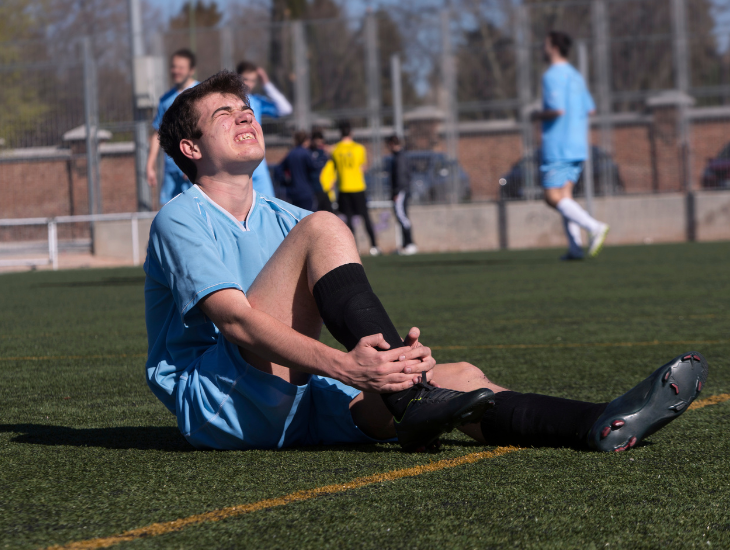For young athletes and their families, participating in sports is a fantastic way to foster physical health, discipline, teamwork, and enjoyment. However, youth sports can also lead to injuries, some of which are peculiar to growing bodies. Recognising, preventing, and treating these injuries is essential for the long-term wellbeing of our active kids.
In this blog, we'll explore five common injuries in youth sports, with a particular focus on Sever's disease and Osgood-Schlatter disease, complemented by real-world feedback from parents shared on our Pitchside Parents Hub discussion page.
5 Common Youth Sports Injuries:
1. Ankle Sprains
Ankle sprains occur when the ligaments that support the ankle stretch beyond their limits and tear. Symptoms include pain, swelling, and limited range of motion.
To help avoid ankle sprains, choosing the right boots is key. Look for boots with a good fit—snug but not tight—with proper arch support and ankle stability. Also, children can help strengthen their ankles at home by doing simple single leg raises while they brush their teeth or watch tv. A balance board is also lots of fun and relatively low-cost.

Immediate treatment for ankle sprains involves rest, ice, compression, and elevation (RICE)
2. Concussions
Concussions, a type of traumatic brain injury, are common in contact sports. Unfortunately even with the Heading Guidance in Training which eliminated or restricted heading at U12 level and below (2021) - a collision with a head, shoulder or ball is still tricky to avoid.
Symptoms can include headache, confusion, dizziness and memory loss. Any concussion necessitates immediate medical attention and a careful return-to-play protocol. The best rule is with any head injury - get it checked out.
3. Sever's Disease
Sever's disease is a painful heel condition that affects children undergoing growth spurts. It results from inflammation of the growth plate in the heel. Feedback from some of our Laceeze parents underscores the impact of Sever's disease on young athletes. Compression supports, ice, and careful attention to footwear can alleviate symptoms. One mother emphasises the importance of proper shoes and in-soles to avoid triggering Sever's discomfort, while another shares how alternative treatments like acupuncture offered relief for her child.

4. Osgood-Schlatter Disease
This condition, characterised by pain and swelling just below the knee, arises from stress on the growth plate at the top of the shinbone. One father’s experience with Osgood-Schlatter highlights the challenging decisions young athletes must make—balancing their passion for sports with the need to manage pain and prevent long-term damage. Rest, ice, compression, and elevation are crucial for managing symptoms. The good news is that most children grow out of this when they reach adulthood.

5. Sprains and Strains
Sprains affect ligaments, while strains affect muscles or tendons. Both result from overstretching or tearing and are common in various sports, especially football and rugby. Immediate treatment includes RICE, followed by gentle stretching and strengthening exercises.
Read our article on ‘Helpful Stretches for Young Players’
Parental Insights and Advice
Parents like Helen, Sarah, and Anthony (members of our Pitchside Parents Hub) share a common narrative: youth sports injuries are not only physical challenges but also emotional and logistical ones. They highlight several important considerations for parents and coaches:
- Growth Awareness: Rapid growth phases can predispose young athletes to specific injuries. Monitoring growth and adjusting activities accordingly can help mitigate risks.
- Proper Support: Utilising compression supports and paying attention to footwear can provide significant relief.
- Alternative Treatments: When conventional methods fall short, alternative treatments like acupuncture might offer unexpected relief, demonstrating the importance of an open-minded approach to managing sports injuries.
- Importance of Warm-Up and Cool-Down Routines: The absence of proper warm-up and cool-down routines is a common concern among parents. Incorporating stretching and flexibility exercises before and after play can prevent injuries and enhance performance.
- Listening to Young Athletes: Encouraging young athletes to communicate their discomfort and pain can lead to early intervention and prevent more serious injuries.
Ask the Expert
We spoke to Jason Rendell BSc(Hons) MRCPod, an HCPC registered podiatrist who provides services for AFC Bournemouth football club, to give us some of his professional advice.
“Encouraging young people to participate in sport at any level is so important for their long term physical and mental health. 40% of girls drop out of their sport by the end of puberty. This is a frightening statistic … and needs to change.
Injuries in sport happen, a bump in road so to speak. Having read some of the advice on the Pitchside Parents Hubpage I agree treating the person, not just the injury, is so important.
The mental side of being injured requires careful attention such as fear of injury reoccurrence or losing their place in the team etc.
If you child does get injured, please always seek professional advice, don’t rely on the internet.
As a parent (I have 2 children) it’s very hard to be objective about our children, especially health matters, we are too invested. So please listen to the professional’s advice, work with them. If you child has been advised to be stronger or more flexible or even to back off for a while – support and encourage the process. Above all, try to keep sport fun to encourage longevity.”
For more information visit Jason’s website.
Conclusion
Conditions like Sever's disease and Osgood-Schlatter disease remind us of the unique challenges young athletes face. The insights shared by parents within our Laceeze community emphasise the need for awareness, proper injury management, and the support young athletes require to thrive both on and off the field. As parents and coaches, fostering an environment that prioritises health, wellness, and safe sports practices is crucial for nurturing the next generation of athletes.
Join the discussion
We’d love to hear your stories and tips on managing youth sports’ injuries. Join the friendly chat on our community page – the Pitchside Parents Hub - and share your experiences with our like-minded parents. Your insights could help support other parents and young athletes navigating similar challenges.


0 comments